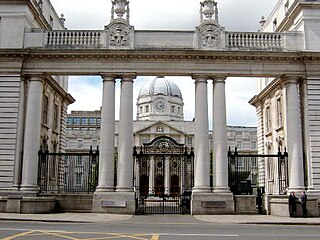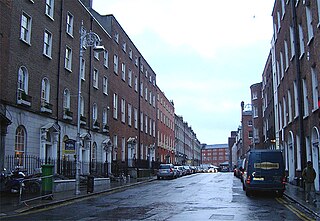
Leinster House is the seat of the Oireachtas, the parliament of Ireland. Originally, it was the ducal palace of the Dukes of Leinster. Since 1922, it has been a complex of buildings of which the former ducal palace is the core, which house Oireachtas Éireann, its members and staff. The most recognisable part of the complex, and the "public face" of Leinster House continues to be the former ducal palace at the core of the complex.

Merrion Square is a Georgian garden square on the southside of Dublin city centre.

Ailesbury Road, is a tree-lined avenue in the affluent Dublin 4 area in Dublin, Ireland. It links Sydney Parade Station on Sydney Parade Avenue and the Church of the Sacred Heart at Anglesea Road, Donnybrook. Historically, many embassies and diplomatic residences have been located on the road, including the striking residence of the French Ambassador, the embassy of the People's Republic of China, and the Japanese embassy.

Earl of Mornington is a title in the Peerage of Ireland. It was created in 1760 for the Anglo-Irish politician and composer Garret Wellesley, 2nd Baron Mornington. On the death of the fifth earl in 1863, it passed to the Duke of Wellington; since that date, the title has generally been used by courtesy for the heir apparent to the heir apparent to the dukedom.

St Stephen's Green is a garden square and public park located in the city centre of Dublin, Ireland. The current landscape of the park was designed by William Sheppard. It was officially re-opened to the public on Tuesday, 27 July 1880 by Lord Ardilaun. The square is adjacent to one of Dublin's main shopping streets, Grafton Street, and to a shopping centre named after it, while on its surrounding streets are the offices of a number of public bodies as well as a stop on one of Dublin's Luas tram lines. It is often informally called Stephen's Green. At 22 acres (8.9 ha), it is the largest of the parks in Dublin's main Georgian garden squares. Others include nearby Merrion Square and Fitzwilliam Square.

Belvedere House and Gardens is a country house located approximately 8 kilometres (5 mi) from Mullingar, County Westmeath in Ireland on the north-east shore of Lough Ennell. It was built in 1740 as a hunting lodge for Robert Rochfort, 1st Earl of Belvedere by architect Richard Cassels, one of Ireland's foremost Palladian architects.

Garret Colley Wesley, 1st Earl of Mornington was an Anglo-Irish politician and composer, as well as the father of several distinguished military commanders and politicians of Great Britain and Ireland.
The architecture of Ireland is one of the most visible features in the Irish countryside – with remains from all eras since the Stone Age abounding. Ireland is famous for its ruined and intact Norman and Anglo-Irish castles, small whitewashed thatched cottages and Georgian urban buildings. What are unaccountably somewhat less famous are the still complete Palladian and Rococo country houses which can be favourably compared to anything similar in northern Europe, and the country's many Gothic and neo-Gothic cathedrals and buildings.

Merrion Street is a major Georgian street on the southside of Dublin, Ireland, which runs along one side of Merrion Square. It is divided into Merrion Street Lower, Merrion Square West and Merrion Street Upper. It holds one entrance to the seat of the Irish Parliament, the Oireachtas, major government offices and two major cultural institutions.

Booterstown is a coastal suburb of the city of Dublin in Ireland. It is also a townland and civil parish in the modern county of Dún Laoghaire–Rathdown. It is situated about 7 km (4.3 mi) south of Dublin city centre.

Ely Place is a street in central Dublin with Georgian architecture. It is a continuation of Upper Merrion Street and the place where Lower Baggot Street and Merrion Row meet. Both the latter and Hume Street link it to St Stephen's Green.

Mornington is a coastal village on the estuary of the River Boyne in County Meath, Ireland approximately 5 km downriver from the centre of Drogheda. Together with the neighbouring villages of Laytown, Bettystown and Donacarney, it comprises the urban area of Laytown–Bettystown–Mornington–Donacarney with a combined population of 15,642 at the 2022 census.
Michael Stapleton is regarded as having been the most skilled stuccodore working in the neoclassical or "Adam" style that dominated Dublin interior decoration in the final decades of the 18th century.

Merrion Hotel is a hotel in Dublin, Ireland, which comprises a block of four terraced houses on Upper Merrion Street, built in the 1760s by Charles Monck, 1st Viscount Monck, for wealthy Irish merchants and nobility. He lived in No. 22, which became known as Monck House. The first of these Georgian houses, Mornington House, is the reputed birthplace of Arthur Wellesley, 1st Duke of Wellington. It is half owned by Lochlann Quinn. The hotel also incorporates, as a separate business, Dublin's only 2-star Michelin restaurant, Restaurant Patrick Guilbaud.
Charles Stanley Monck, 1st Viscount Monck, was born in 1754 and died on 9 June 1802. He was the 1st son of Thomas Monck MP, by his wife, Judith Mason, daughter of Robert Mason, of Mason Brook.

Richard Colley Wesley, 1st Baron Mornington was an Irish peer, best remembered as the grandfather of Arthur Wellesley, 1st Duke of Wellington.

Merrion Castle was a castle situated about 300m south of the present-day Merrion Gates, to the south of Dublin city centre. Built in the early fourteenth century, it was from the sixteenth century to the early eighteenth century the principal seat of the Fitzwilliam family, who acquired the title Viscount Fitzwilliam. After the Fitzwiliams moved to Mount Merrion House in about 1710 the castle fell into ruin, and it was demolished in 1780, though there were remains visible as late as 1837. No trace of Merrion Castle survives today. It was located opposite Merrion Gates, on the site of St. Mary's Home and School for the Blind. Its location, and the modern site of St.Mary's, can be seen on historical maps, including the six-inch (1829-1841) Ordnance Survey of Ireland maps.

Dangan Castle is a former stately home in County Meath, Ireland, which is now in a state of ruin. It is situated by Dangan Church on the Trim Road. The castle is the former seat of the Wesley (Wellesley) family and is located outside the village of Summerhill. It was the childhood home of Field Marshal Arthur Wellesley, 1st Duke of Wellington.

In British usage, the term townhouse originally referred to the opulent town or city residence of a member of the nobility or gentry, as opposed to their country seat, generally known as a country house or, colloquially, for the larger ones, stately home. The grandest of the London townhouses were stand-alone buildings, but many were terraced buildings.
















